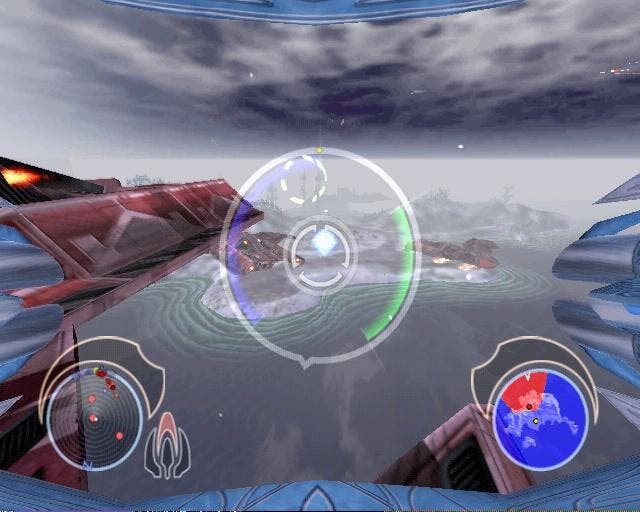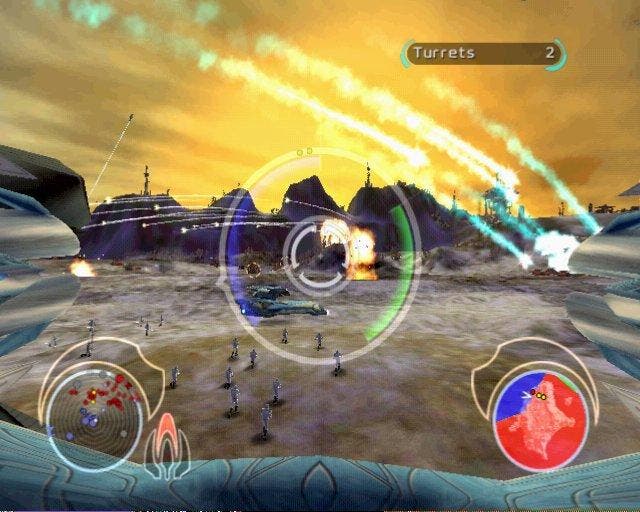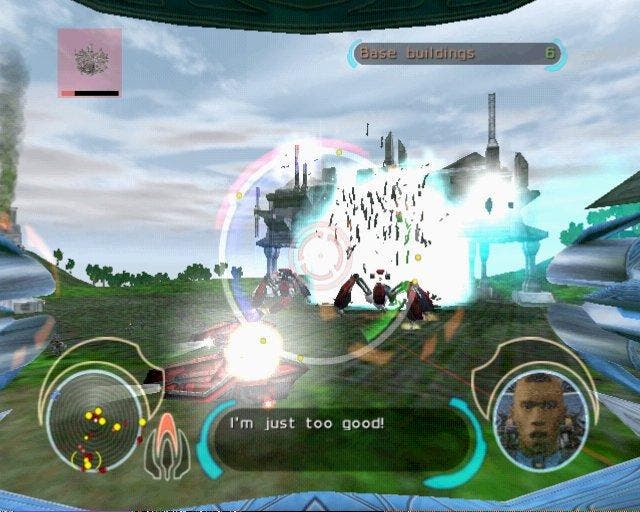Battle Engine Aquila
First Impressions - Rob goes hands-on with this UK-developed mechtacular
Giant transforming robots armed to the teeth with ludicrously overpowered weapons are generally the sole preserve of the Japanese, making Battle Engine Aquila into something of an oddity - a slick and stylish shoot 'em up featuring a mech that transforms from ground-based walker mode into a flying jet at the drop of a hat, but developed not in some bustling suburb of Tokyo, but in our very own damp English town of Guildford.

Cultural Exchange
Don't let that put you off, however; defying the tradition of noble (and some not-so-noble) failures when British companies try and pull off Japanese game concepts, UK developer Lost Toys has actually created a hugely impressive game which is, judging from our playtime with it, entirely indistinguishable in terms of quality and polish from anything you'd find under the eaves of Akihabara's software stores.
The plot, like the best mints, is wafer thin; you play Hawk, a young pilot with "attitude" whose talent at illegal mech-racing contests brings him to the attention of Forseti (that's your lot) military commanders looking for the right man to take the controls of their latest and greatest battlefield toy in the ongoing fight against their enemies, the Muspell. The game is set on an almost drowned world, so in a move a little reminiscent of Rage's classic Hostile Waters [and don't lets forget Kevin Costner's Water World - Ed], all combat takes place on islands - the last remaining archipelagos of dry land on the planet.

Aibo's Biggest Brother
So, strapped into the cockpit of the Battle Engine (a sleek-looking piece of kit which is a far cry from the chunky bipedal beasts of Mechwarrior) off you go to blow things up. The viewpoint is locked to a first-person perspective, which can feel a little restrictive at first, but quickly begins to feel very natural and intuitive. The controls are equally easy to get used to, being effectively standard FPS controls - left stick moves forward and back and strafes, while the right stick is used for freelook. The triggers are used for weapon switching and firing, and the other buttons on the pad handle functions like switching from walker mode to flight mode or firing your retro thrusters to avoid embarrassing high speed meetings with the ground.
Each level of the game has a variety of different objectives, often focused on defending certain friendly installations or vehicles from waves of enemy attack, or on pushing the Muspell forces off the island entirely by spearheading an assault. Secondary objectives are also usually provided, which aren't vital to progressing through the game but will allow you to improve your ranking on the level, thus unlocking additional bonuses.

Big Fish in a Bigger Pond
The chief innovation of Battle Engine Aquila is the fact that, impressive as your mech is, it's only a small part of a much bigger force comprising army, navy and air force units. At first, the temptation to rush headlong into enemy lines is overwhelming, and indeed such an approach works relatively well for some of the earlier levels - giving you a crash-course in controlling the mech by allowing you to barrel around shooting things with little regard for what's happening elsewhere.
A few levels in, however, you'll suddenly find yourself experiencing utterly crushing defeat on a regular basis - and it's then that a certain epiphany is experienced with the game, as you start to take a bit more notice of what the rest of your troops are doing. You have no direct control over your forces, but there's a subtle and important relationship there nonetheless - your actions affect the progress of your troops across the level in a very fundamental way, revealing an almost totally unscripted AI in control of forces on both sides.
This is the key to the game, and it's what sets Battle Engine Aquila apart from almost every other mech game on the market right now. Rather than your army supporting you, you're actually there to support them - shoring up the front line where it seems in danger of collapsing, destroying opposition on the way to key enemy installations and then letting your allies take out the buildings and mop up the Muspell forces, or just allowing your troops time to proceed up a beachhead before trying to take on the enemy batteries further up the island alone.

Shooting Script
This isn't to say that Battle Engine's gameplay is entirely unscripted, because despite the impressive AI demonstrated on both sides of the battlefield, there are a lot of scripted events in the game. Wings of enemy bombers (one of the most evil units in the game) show up as regularly as clockwork; assaults on your bases channel through the same valleys or mountain passes every time a level is replayed. However, this is no bad thing, as it means that you'll never defeat a tricky level simply because you got lucky and the enemy AI screwed up. The scripting is designed to set the enemy AI on the right path, rather than replacing the AI entirely.
Of course, if you destroy the factory producing the tanks attacking your base, then there'll be no tanks to attack - script or no script. Take out enemy emplacements and allow your armoured divisions to pour into a valley, and there'll be no more attacks from that quarter. The game quickly begins to benefit from the initially frustrating lack of any way to control your troops directly - placing you in the role of a shepherd guiding and protecting your flocks, albeit a three storey high metal shepherd with flocks of bloodthirsty marines and heavily armoured tanks spitting white hot death at the enemy.

Island Life
Battle Engine Aquila doesn't disappoint in the graphics department either, throwing around massive armies, impressive explosion and weapon effects, detailed islands and even heavily forested woodland without breaking a sweat. Although nothing in the game is particularly detailed, the sheer number of things on screen at once more than makes up for it, and there's a definite design flair in the way that the developers have covered up the relatively low polygon count of their units and buildings.
Especially stunning is the ability to take off, fly up as high as possible and then look down at the entire island spread out below you - complete with battle in progress. It's an effect that the world ooh'd and ahh'd over when Lionhead did it first in Black & White; seeing it pulled off in such an action focused console title is still very impressive. The one black mark against the game, sadly, is the rendered video sequences; although the outdoors bits with mechs running around the place look fine, as soon as human characters show up and start talking the animation is almost cringeworthy.
Finishing Touches
We're less than halfway through Battle Engine Aquila at the moment - not counting the stacks of alternate levels to be unlocked by achieving high enough rankings - and we can pretty honestly say that we're impressed. So far, the game is slick, addictive and a hell of a lot of fun, and it seems to have plenty of longevity to boot. We'll be putting in plenty of playtime and letting you know our final thoughts on the game a little bit closer to its release - currently pencilled in lightly for February 7th.

